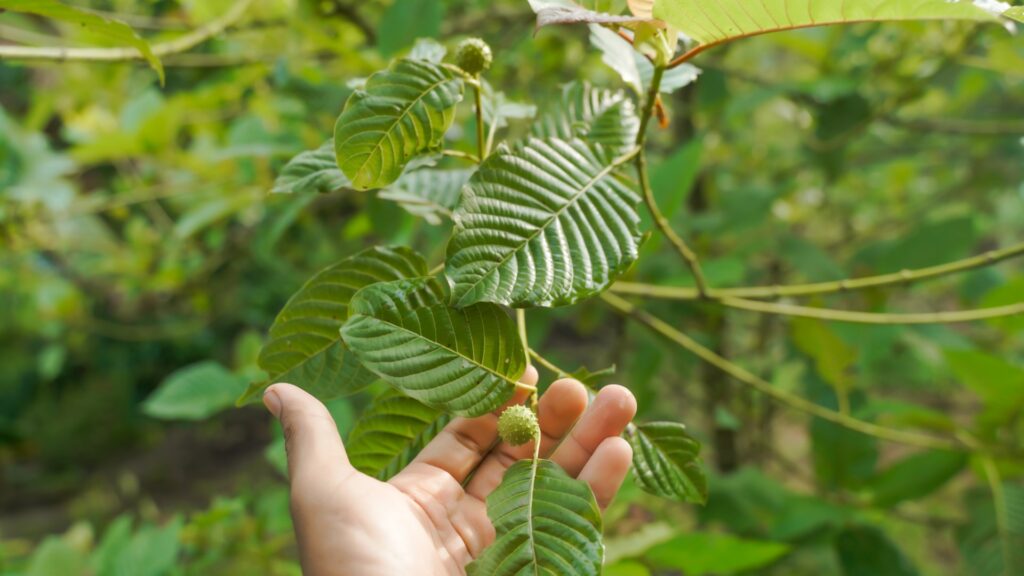Kratom has already turned into a botanical sensation, as people enjoy its open effect as well as for a variety of purposes. However, most individuals who use kratom do not have a clear idea of how the kratom tree undergoes the process of being transformed from the contentious kratom tree in Southeast Asia rainforests to powder and delicately milled extracts in stores all over the world.
In this blog, we’ll give you a detailed, step-by-step tour of the lifecycle of the kratom tree, the journey through the fields in which it is grown, the harvesting of this growing medicinal and practical wonder, and finally, the conversion into the products so many people use today.
What Is the Kratom Tree?
The kratom tree (Mitragyna speciosa) is an evergreen tropical shrub, and can be found in Southeast Asia, especially in the wet and steamy regions of Thailand, Malaysia, Indonesia, and others.
As a member of the Rubiaceae family (the coffee family), kratom trees will grow up to 25 meters (about 80 feet) in height in their natural habitat. Kratom trees with their wide, shiny, dark green foliage and clusters of yellow flowers are as culturally important as they are beautiful to the eye.
Historical and Cultural Significance
Kratom leaves have enjoyed a long traditional history of usage by labourers and villagers in Southeast Asia to overcome fatigue, to increase stamina, and even as a natural treatment for conditions like pain, diarrhea, and fever.
The earliest written account of the kratom tree by a Westerner was given by Dutch botanist Pieter Willem Korthals in the 19th century, which detailed the properties and uses of the tree.
Growing Kratom: From Seed to Sapling
The Challenge of Germination
Growing kratom trees from seed is a notoriously difficult process. Kratom seeds are tiny and have a short window of viability, requiring immediate planting in moist, nutrient-rich soil. Successful germination demands:
- High humidity
- Consistent warmth (ideally 75–90°F)
- Filtered sunlight
- Rich, slightly acidic soil (pH ~6.0)
Remarkably small amounts of seeds (less than a percent) will germinate even in the best conditions. This is the reason why most cultivators tend to propagate kratom plants with cuttings that root more treasured and easily.
Caring for Young Kratom Plants
Once established, kratom saplings need:
- Plenty of water (without waterlogging the roots)
- Protection from strong winds
- Regular feeding with organic fertilizer high in nitrogen, potassium, and phosphorus
- Pruning to encourage bushier growth and prevent weak, spindly stems
Kratom tends to develop pests such as spider mite and white fly, besides diseases caused by fungus. To make the plants healthy, there is the use of organic pest control such as neem oil or insecticidal soap, is used.
The Mature Kratom Tree
The growth of a mature kratom tree is also imposing as it covers a large area, its canopy is wide, and the leaves have a length of up to 20 centimeters. The color of the vein of each of the leaves, white, green, or red, varies with the age of the tree, and is a factor in the division of kratom strains.
- White vein: Youngest leaves, typically more stimulating
- Green vein: Intermediate maturity, balanced effects
- Red vein: Oldest leaves, often more sedating
The surroundings in which the tree grows, such as soil, rainfall, sunlight even the microclimate, have a major part to play in dictating the alkaloid level and the overall quality of the leaves.
Harvesting the Kratom Leaf
Timing and Technique
The process of harvesting is a craft and usually manual. The farmers pick leaves of plants that are fully developed, green in color, and with the highest alkaloid content, allowing newly grown leaves to grow. The timing of the harvest is critical:
- Younger leaves (white vein) are picked for their stimulating effects
- Mature leaves (green and red veins) are harvested for balanced or sedative effects
Harvesters avoid damaged or diseased leaves, ensuring only the healthiest foliage is collected.
The Importance of Vein Color
Every kratom tree has leaves that change in color of veins throughout the life of the tree. A mature white color leaf can turn green, and even red. These advancements in nature enable the farmer to pick individual leaves to achieve certain effects.
Post-Harvest Processing: From Leaf to Powder
Cleaning and Sorting
Upon harvesting, the leaves of kratom are washed to get rid of dirt and other litter and assessed as to their quality. Each of the best leaves goes through to the next step.
Drying Methods
Drying is a crucial step that influences the final product’s potency, color, and flavor. There are two main approaches:
- Indoor drying: The fan-ventilated dark rooms are used to spread the leaves to maintain the required level of humidity and avoid mold. This way leaves more of the natural alkaloids and color of the leaves.
- Outdoor drying: Sun-drying of leaves can take place (24 72 hours), which can increase some alkaloids, but can also give rise to a darker, earthier product.
Others, like yellow or gold kratom, are fermented further or dried in a special way to change the alkaloid content and the effect that this variety of kratoms can produce.
Crushing and Grinding
When the leaves are dry, they can be powdered by hand or machine into crumbs. The bitterness may be reduced by the removal of some of the stems and veins to improve the texture.
The crumbs are then pulverized into fine powder with the help of industrial grinders. Most kratom products in the market are derived using this powder.
Quality Control and Packaging
Before packaging, the kratom powder undergoes:
- Sifting to remove large particles and stems
- Laboratory testing for purity, potency, and contaminants
- Air-tight, moisture-proof packaging to preserve freshness and prevent spoilage
Other preparations aim at supplying some of the powders in capsules to facilitate the dosage process, and others pack them in quantities to be processed into extracts or mixtures.
From Powder to Extract: The Final Transformation
Making Kratom Extracts
Kratom extracts are concentrated forms of the plant’s active alkaloids. The process typically involves:
- Soaking kratom powder in a solvent (often water and ethanol)
- Heating and simmering to extract the alkaloids
- Filtering to remove plant material
- Evaporating the solvent to yield a thick, resinous extract
This extraction can be subjected to more processing into tinctures, resins or hyper-potent powders and capsules. Extracts are strong and convenient, but dosing is highly essential since they are potent.
Blending and Batching
A combination of various strains and batches is often used by the manufacturers to provide a constant alkaloid pattern and effect. This certification makes every product a reliable result, even in case of seasonal or regional differences in the raw leaves.
The Kratom Tree in the Wild and at Home
The Kratom Tree’s Natural Habitat
The kratom tree grows in the rainforest and is indigenous to the region of Southeast Asia. It matures with other tropical giants, and it grows in rich loamy soils and a high-humidity climate of riverbanks and flood plains.
The wild kratom trees may last a number of decades, and the leaves are grown throughout the year.
Growing Kratom at Home
Cultivating kratom outside its native environment is challenging but possible with the right care:
- Climate: Warm, humid, and frost-free
- Soil: Rich, well-draining, slightly acidic
- Light: Bright, indirect sunlight
- Water: Consistent moisture without waterlogging
Large containers, humidity domes, and grow lights are used in an effort to simulate the tropical environment by indoor growers. Pruning makes the plants grow bushier and produce more leaves.
The Science and Safety of Kratom
Alkaloid Content
Kratom leaves possess more than 40 alkaloids, some of the most important ones are mitragynine and 7-hydroxymitragynine. These are the compounds that produce stimulating or sedative effects of kratom, depending on the dose and strain.
Effects and Uses
- Low doses: Stimulant effects (increased energy, alertness, sociability)
- High doses: Sedative effects (relaxation, pain relief, drowsiness)
- Traditional uses: Chewed fresh, brewed as tea, or used in folk medicine for pain, diarrhea, and fatigue
Safety and Legal Status
The FDA does not recognize kratom as a drug of anesthetic incorporation; the U.S. DEA categorizes it as a drug and chemical of concern. Its use is prohibited in some states and controlled in other countries.
The side effects may consist of nausea, constipation, dry mouth, and, at large doses, dependence or withdrawal symptoms.
Final Thoughts
The expedition of the kratom tree is a tale of legacy, of research, and of attention to detail, not to mention an ideal combination of all three aspects. Every stage, one that goes through a seed to a sapling, a mature tree to a harvested leaf, and lastly, an extraction, needs skills and tending care.
Being aware of this process can increase the appreciation of the remarkable qualities of kratom, but it will also highlight the issue of quality, sustainability, and sustainable use.
Being a novice or an experienced lover, it is useful to know where your kratom has been and how it has found its way to you so you can make informed decisions about the ingredients you take and develop a deeper appreciation of this wonderful plant and the specific communities that bring it to us.

